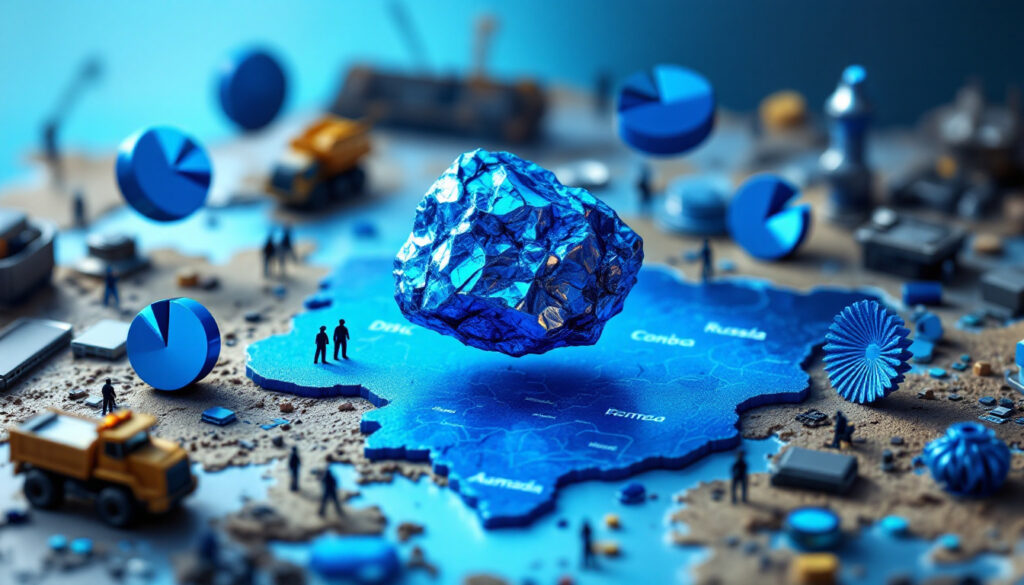Cobalt Production by Country: Global Supply Chain Analysis 2025
The global market has evolved rapidly, with modern data on cobalt production by country shaping investment strategies. In this analysis, we discuss production trends, geopolitical challenges, and technological adaptations. Furthermore, discussions are enriched with insights from data on extraction methods and supply chain dynamics.
The Global Cobalt Landscape
The global cobalt supply chain remains heavily concentrated. The Democratic Republic of Congo (DRC) maintained dominance by producing a staggering 111.30 tonnes in 2022. This represents 73.4% of global output and exemplifies the challenges in ensuring ethical extraction methods.
Total global production reached 151.60 tonnes in 2022. Moreover, the top five producing countries accounted for 134.7 tonnes (88.9% of global production). Additionally, Chinese companies significantly influence operations especially when copper byproducts are involved, as seen in top copper mines production trends.
Unlike metals mined solely for their primary value, cobalt is mostly extracted as a by-product of copper and nickel mining. For instance, metal price volatility directly affects extraction processes. In addition, mining’s role in the clean energy transition emerges as a major driver in investment decisions.
Top Cobalt Producing Countries
This section provides an overview that further clarifies cobalt production by country. Each region presents unique challenges and opportunities.
Democratic Republic of Congo (DRC)
Annual production in the DRC reached 111.30 tonnes in 2022. The country's dominance is strategic for global technology supply chains, especially as electric vehicle production scales worldwide.
Chinese ownership is significant, demonstrated by companies such as CMOC Group’s Tenke Fungurume Mine, which ranked as one of the top global producers. Moreover, artisanal mining contributes 15-30% of the output. Amnesty International has noted that ethical practices are in their infancy.
The prevalent extraction method of hot acid leaching achieves 95% cobalt recovery rates but raises environmental concerns. Initiatives like the Fair Cobalt Alliance have improved conditions for around 50,000 miners.
Russia
Russia stands as the world’s second-largest producer with 8.90 tonnes in 2022, capturing approximately 5.9% of global output. Production is concentrated in Arctic operations by Norilsk Nickel with an annual yield of about 4.1K tonnes.
However, geopolitical complexities such as sanctions following the Ukraine conflict have disrupted exports. Consequently, western countries are reassessing supply reliability and seeking diversification strategies.
Australia
Australia is the third-largest producer with 5.90 tonnes in 2022. Increasingly, manufacturers are looking towards "ethical cobalt" sources. For instance, Glencore’s Murrin Murrin Mine, with a production of about 4.6K tonnes in 2023, is renowned for its ISO 14001 environmental certification.
Australia’s clear regulatory environment and strong governance make its products highly desirable. The nation's premium positioning is further supported by governance challenges and strategic insights in mining.
Philippines
The Philippines emerged as the fourth-largest producer with 4.70 tonnes in 2022. The Rio Tuba Nickel Project is central to its production, using High-Pressure Acid Leaching (HPAL) to unlock resources.
This innovation has been pivotal in altering global supply dynamics. As nations seek supply diversification, the Philippines now plays a critical role in the modern supply chain.
Canada
Canada rounds out the top five with 3.90 tonnes in 2022. Known for its stringent regulatory standards and community engagement protocols, Canada has secured its position in the market.
The First Cobalt Refinery in Ontario now supplies around 25% of U.S. electric vehicle manufacturing needs. In addition, favourable government support and robust oversight are key reasons for its success. For further discussion on market impacts, see global commodities market insights.
How Has Cobalt Production Changed Over Time?
Historical data shows dramatic shifts in production centres. Production outside the major producers has increased from 1,800 tonnes in 1998 to 14,700 tonnes in 2022. This represents a remarkable 716% surge over the stated period.
Emerging producers are gaining market share as demand increases. For instance, Indonesia is planning High-Pressure Acid Leaching projects to add roughly 40,000 tonnes by 2027. Furthermore, recycling now meets roughly 12% of the demand and is expected to rise to 22% by 2030.
Recycling operations recover 90-95% of cobalt from used batteries. In addition, ESG challenges and opportunities in mining have pushed companies to improve waste management and recovery practices.
What Is Cobalt Used For?
Cobalt’s applications are both traditional and modern. First, it is used in electroplating because of its exceptional oxidation resistance. Secondly, its pigment properties are crucial in ceramics and glass production, demonstrating notable durability.
In modern times, cobalt is essential in lithium-ion batteries where it stabilises cathode structures. However, evolving chemistries have reduced usage significantly. For example, NMC-811 batteries use 60% less cobalt than earlier models while still maintaining 90% energy density.
Industrial uses also include heat-resistant alloys for turbine blades. Consequently, cobalt remains integral for applications that demand reliability under extreme conditions.
The Electric Vehicle Revolution and Cobalt
The electric vehicle (EV) industry has historically relied on cobalt-rich batteries. Early EV models required up to 20kg of cobalt per vehicle, creating significant supply chain vulnerabilities.
Tesla, however, has reduced its dependence. Its shift to LFP (Lithium Iron Phosphate) batteries now powers around 58% of its Model 3 and Model Y fleet. Furthermore, this transition has substantially decreased per-vehicle cobalt use and minimised exposure to supply constraints.
In addition, evolving battery chemistries illustrate mining’s role in the clean energy transition, as manufacturers seek to balance performance with ethical sourcing.
Geopolitical Implications of Cobalt Supply
Supply Chain Vulnerabilities
The extreme concentration of production in the DRC creates significant vulnerabilities. With 73.4% of global output coming from one country, supply disruptions can have far-reaching impacts.
This risk is compounded by Chinese control over major DRC operations, creating a double bottleneck. Furthermore, infrastructural and political challenges intensify these issues. As a result, many economies now classify cobalt as a critical mineral, prompting urgent reforms and increased recycling initiatives.
Historical Conflicts Over Resources
Colonial-era conflicts continue to colour the modern landscape. The exploitation during Belgian colonial rule laid a challenging foundation that persists today.
Modern tensions extend into the realm of multinational investments. Chinese companies have secured dominant positions, prompting western nations to re-assess dependencies. This evolution contributes to ongoing debates in governance challenges and strategic insights in mining.
In addition, violence and conflict in cobalt-producing regions further complicate ethical sourcing. Consequently, governments and industry players are compelled to seek fairer supply chain practices.
The Future of Cobalt Production
This section reflects on emerging trends in cobalt production by country. New sources and technological advancements are expected to shape the market further.
Emerging Alternative Sources
Deep-sea mining holds promising potential with polymetallic nodules in the Clarion-Clipperton Zone. Although these nodules contain an estimated 120 million tonnes of cobalt, environmental and legal hurdles remain.
Moreover, recycling initiatives are accelerating. Specialized facilities are now achieving recovery rates above 90%. As electric vehicles reach end-of-life, urban mining is set to become increasingly significant.
Secondary markets are also developing. Researchers are reprocessing historical mine tailings, which now represent viable sources due to improved extraction technologies. For more global trends, check out an overview of cobalt mining.
Technological Adaptations
Battery technologies continue to evolve. New chemistries such as NMC‑811 have drastically lowered cobalt usage while retaining performance. In addition, solid‑state electrolytes may eventually eliminate cobalt altogether.
Companies are responding through strategic stockpiling and vertical integration. For instance, Apple has entered into direct procurement deals with miners, ensuring ethical sourcing. Similarly, academic research published on cobalt information supports the drive for reduced dependency.
Ethical Considerations in Cobalt Mining
Human rights and environmental concerns remain central. Reports by Amnesty International have highlighted widespread ethical issues in artisanal mining. Consequently, initiatives for responsible sourcing have gained traction.
Environmental impacts such as acid mine drainage and habitat destruction persist. Conventional methods generate 5-10 tonnes of waste per tonne of cobalt. Nonetheless, industry programmes now involve third-party audits and community development.
Efforts include the Responsible Minerals Initiative, which now covers about 380 companies. These programmes facilitate traceability and have helped reduce child labour by significant margins.
FAQ About Global Cobalt Production
Which country has the largest cobalt reserves?
The DRC holds roughly 3.5 million tonnes of identified cobalt reserves. This figure represents over 50% of the world’s known reserves, indicating the nation’s long-term strategic influence. Australia and Indonesia follow with 1.2 million tonnes and 600,000 tonnes respectively.
How is cobalt typically extracted?
Cobalt is primarily recovered as a by-product of copper and nickel mining—only 2% stems from primary cobalt operations. Typically, industrial processes involve leaching the crushed ore with sulfuric acid. Following this, solvent extraction and electrowinning yield pure cobalt. For further details, refer to an overview of cobalt mining methods.
Artisanal practices also exist, albeit with significant environmental and safety challenges.
What impact does cobalt mining have on local communities?
Mining communities experience both benefits and costs. Economic gains include employment and improved infrastructure. Nevertheless, environmental degradation, respiratory diseases, and occupational hazards are common. Systematic benefit-sharing and community programmes now aim to address these issues. In fact, studies suggest that mining regions may enjoy up to 27% higher incomes, although distribution remains unequal.
Will cobalt remain essential for battery production?
Despite emerging alternatives, cobalt production by country remains critical for many premium applications. While early EV batteries used 10-20kg of cobalt, innovations have reduced requirements substantially. Future forecasts confirm that cobalt production by country will continue to be essential in applications demanding maximum energy density through at least 2035.
Each question reflects ongoing challenges and adaptations in a volatile market. Consequently, technological and ethical improvements are key to sustaining a responsible supply chain.
Are You Looking for Actionable Insights on Cobalt Discoveries?
Discover how you can leverage real-time alerts on significant cobalt discoveries with Discovery Alert's proprietary Discovery IQ model. Explore potential market-changing opportunities by visiting Discovery Alert’s discoveries page here and position yourself for a market-leading edge today.




